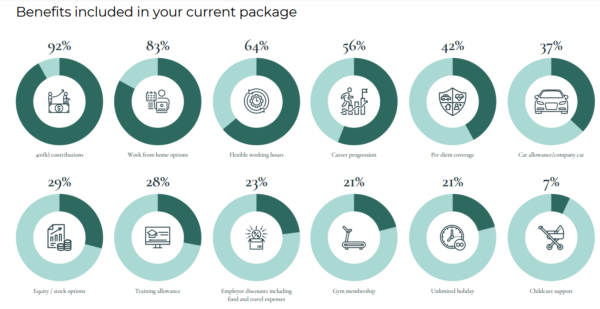Solar energy is a burgeoning industry, as the United States has set its sights on reaching 100% carbon pollution-free electricity by 2035. By the end of last year, over 250,000 Americans were employed in the solar industry, growing 9% over the previous year.
Solar jobs have doubled from about 100,000 in the last ten years, and the next ten are set to be even more historic as the Inflation Reduction Act sets aside $370 billion in climate and energy spending, much of it focused on boosting U.S. solar.
RO Energy, a clean energy and infrastructure recruitment site, released its annual Salary Guide to illuminate what opportunities lie in this industry. The results are based on answers from over 400 respondents.
By market focus, across all job types, salaries were as follows:
Entry-level (0-2 years) commercial and industrial (C&I) workers were paid $80,700, entry level distributed generation workers $69,600, utility-scale $80,800, storage $79,200, and EV and EV infrastructures were $87,000.
Mid-career workers (6-10 years) were paid as follows: C&I $145,500, distributed generation $137,800, utility-scale $144,100, storage $175,000 and EV $141,700.
Late-career workers (15+ years) were paid: C&I $175,000 distributed generation $185,000, utility-scale $190,000, storage $205,000 and EV $200,000.
According to the previous year’s 2020 survey, construction jobs across all sectors paid around $84,600 entry-level. Construction workers with six to 10 years experience made $126,000, and those with 16+ years reported making $170,600. In development jobs, the first two years of experience led to an average pay of $87,600. That rose to $129,200 by years six to 10, and $187,100 for those working in the industry for 16 or more years.
Engineers and operations and maintenance (O&M) workers started off with the lowest salaries, $77,500 and $67,500, respectively. By year six to 10, engineers were paid an average of $94,200 annually and O&M pros made $121,800. By year 16, engineering jobs paid $127,600 on average, and O&M roles made $174,000.
Finance offered the highest pay levels in solar: an average of $94,000 for the first two years of experience, $149,100 years six to 10, and $195,000 for experience beyond 10 years.
The 2021 study found that there is a gender pay gap of about 18% in favor of men in the industry for early-career participants, but by mid-career, six to ten years, there is a slight pay gap in favor of women. The industry essentially reaches pay parity in mid- to late careers, but the survey highlights the need for gender pay equality in early-career opportunities. The survey also found 69% of females and 65% of males do not or do not know if they receive enhanced maternity/paternity leave.
Solar workers appear to be happy in their current roles. On average, across levels of experience and job function, respondents said they would need a 20% to 25% increase in pay to be willing to change jobs.
The survey also highlights benefits available to solar energy workers. The most common benefits were 401(k) contribution (92%), work from home options (83%), and flexible working hours (64%).

When asked what the most important benefits of a solar job are, 29% said that work from home options are most important. This was followed by career progression (18%), 401(k) contributions (16%), flexible working hours (10%) and equity/stock options (9%). Interestingly, 83% of respondents said they receive an annual bonus as part of their compensation.
“With the recent announcement on panel tariffs freezing for the next 24 months, I am sure we are going to see another boom in recruitment from companies that had slowed down due to the uncertainty around foreign panels,” said Emrah Baykal, CEO of RO.
This content is protected by copyright and may not be reused. If you want to cooperate with us and would like to reuse some of our content, please contact: editors@pv-magazine.com.









By submitting this form you agree to pv magazine using your data for the purposes of publishing your comment.
Your personal data will only be disclosed or otherwise transmitted to third parties for the purposes of spam filtering or if this is necessary for technical maintenance of the website. Any other transfer to third parties will not take place unless this is justified on the basis of applicable data protection regulations or if pv magazine is legally obliged to do so.
You may revoke this consent at any time with effect for the future, in which case your personal data will be deleted immediately. Otherwise, your data will be deleted if pv magazine has processed your request or the purpose of data storage is fulfilled.
Further information on data privacy can be found in our Data Protection Policy.